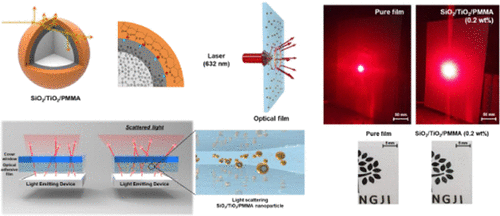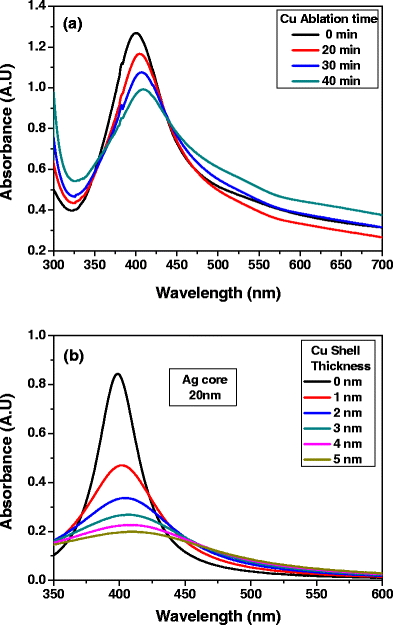

We compare the results for ZnS–polystyrene as core–shell nanoparticle, and ZnS–CdS–polystyrene as core–shell–shell nanoparticle with that of core-only type polystyrene nanoparticles. Mathematical formulation Considering the wide use of polystyrene particles in bio-conjugate experiments, 17,18 we choose different types of layered nanoparticles having outer layer as polystyrene. Most importantly, the present work shows how a judicious choice of nature of excitation, CW or pulsed excitation, can have certain advantage depending on the specific application, whether an impulsive force is to be exerted on the particles or they need to be trapped for longer time. Further, we show the effect of optical nonlinearity under pulsed excitation, which can dramatically influence the trapping efficiency of these nanoparticles. inner shell, can significantly enhance trapping efficiency for the core–shell–shell type nanoparticles, resulting in stable trapping of nanoparticles. It is shown that an appropriate choice of material composition and thickness of the middle layer, i.e. A significant enhancement in trapping efficiency is observed for core–shell–shell type nanoparticles as compared to bare and core–shell type nanoparticles. In this article, we present a comparative study of force and potential on core-only or bare type (polystyrene), core–shell (ZnS–polystyrene) type, and core–shell–shell (ZnS–CdS–polystyrene) type nanoparticles using dipole approximation under both continuous-wave (CW) and pulsed excitation. 14–16 However, due to the facile tuneability of effective polarizability by changing the thickness of layers of multilayered nanoparticles are promised to offer better trapping efficiency. 14 Also, a reversal (from repulsive to attractive) in optical trapping force under pulsed excitation was reported. 12,13 In recent work, we theoretically demonstrated enhanced trapping efficiency for core–shell type nanoparticles over bare ones which was further shown to be fine-tuned by optical nonlinearity under ultrashort pulsed excitation. composed of different materials in layered structures) nanoparticles due to their wide-ranging interesting applications, for example, electromagnetic cloaking using multilayered nanoparticles 11 or enhancing spatial resolution without any compromise with the size of particles during constant force measurement in bioconjugated experiment. Of special interest is to tailor the polarizability of hybrid ( i.e. 7 Further studies revealed the usefulness of exploring as well as harnessing optical nonlinearity under pulsed excitation for dielectric 8–10 nanoparticles. 7 It was demonstrated that the trapping efficiency is characterized by the height of potential barrier to escape the trapping well, i.e. 6 Subsequently, it was realized that under such excitation, nonlinear phenomena, such as the optical Kerr effect (OKE), must be taken into account and OKE was shown to dramatically modulate the trapping efficiency. As an alternative, repetitive instantaneous trapping through the use of high repetition-rate ultrafast pulsed excitation was envisaged. Consequently, to get a stable trap for such particles, very high laser power is used which is otherwise detrimental considering the laser-induced heating, etc. 2–5 Optical trapping of dielectric nanoparticles still remained as a challenging task due to the erratic Brownian motion of these particles which increases with decreasing dimensionality. Introduction Facile manipulation of nanoparticles can be performed using optical trapping 1 to result in wide-ranging applications in nanoscience and nanotechnology. These findings are promised to open up new prospects for controlled nanoscale trapping and manipulation across different fields of nanoscience and nanotechnology.

pulsed excitation or continuous-wave excitation) can be judiciously chosen. high force versus long confinement time), the nature of excitation ( i.e.

Further, the effect of optical nonlinearity under femtosecond pulsed excitation is investigated and it is elucidated that depending on the specific need ( i.e. It is shown that an appropriate choice of material and thickness of the middle layer results in tuning the polarizability, thereby playing a vital role in determining the trapping efficiency for core–shell–shell type nanoparticles. core–shell–shell type nanoparticles, is found to be enhanced compared with both core-only type and core–shell type nanoparticles. The trapping force for multilayered nanoparticles, i.e. Using dipole approximation, a comparative study of trapping force/potential on different types of dielectric nanoparticles is presented.


 0 kommentar(er)
0 kommentar(er)
